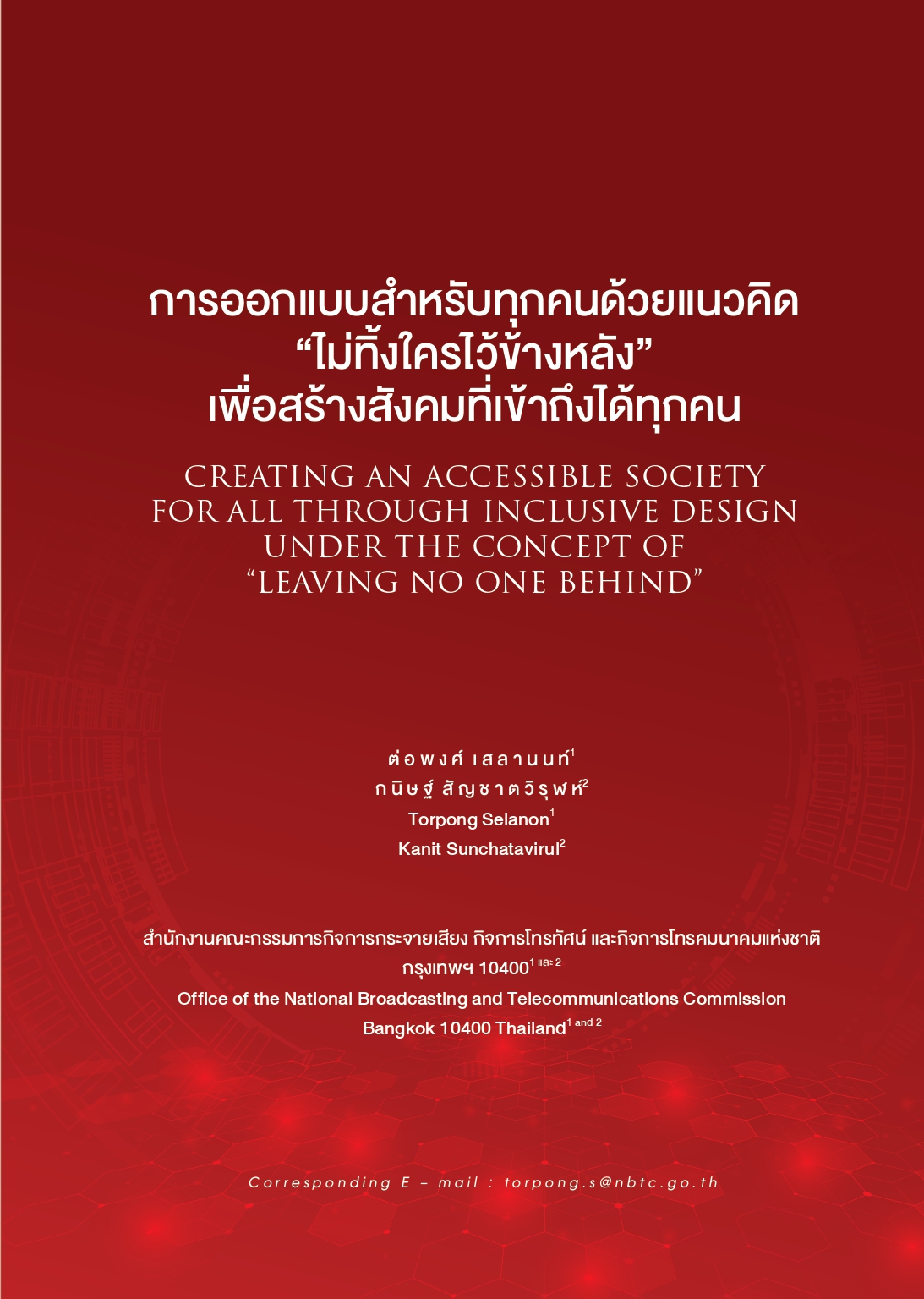Creating an Accessible Society for All Through Inclusive Design under the Concept of "Leaving No One Behind"
Keywords:
Inclusive design, Assistive technology, Digital inclusion, Leaving no one behind, Sustainable Development GoalsAbstract
The objective of this article is to present the concept of “leaving no one behind” in line with the United Nation’s Sustainable Development Goals with the aims to eliminate the digital divide and address the needs of the marginalized and at-risk groups in society, such as the elderly and people with disabilities, as well as to ensure that they could access to and benefit from digital technologies. This documentary research studied and analyzed documents relating to social and environmental factors, and development structures, the importance of the digital divide, and the digital access and recognition development. The study found that by combining inclusive design with assistive technology to invent digital products and services that are accessible by all people, implementing Information and Communication Technology (ICT) accessibility policies and strategies that will support the inclusive and equitable development, and creating the inclusive ICT innovation ecosystem; all people will be able to fully access to and benefit from ICT technologies. This would then lead to the inclusive development that bridge the digital gap and ensure that no one is left behind.
References
ธัญพร มัทวานุกูล. (2566). สถานการณ์คนพิการ 30 มิถุนายน 2566 (รายไตรมาส). กรมส่งเสริมและพัฒนาคุณภาพชีวิตคนพิการ. https://dep.go.th/th/law-academic/knowledge-base/disabled-person-situation/สถานการณ์คนพิการ-30-มิถุนายน-2566-รายไตรมาส
ปราโมทย์ ประสาทกุล, จงจิตต์ ฤทธิรงค์, ศุทธิดา ชวนวัน, ณปภัช สัจนวกุล, สุภรต์ จรัสสิทธิ์, และกาญจนา เทียนลาย. (2565). สถานการณ์ผู้สูงอายุไทย พ.ศ. 2564. สถาบันวิจัยประชากรและสังคม มหาวิทยาลัยมหิดล. https://ipsr.mahidol.ac.th/post_research/situation-of-the-thai-older-persons-2021/
รชนีกร ศรีฟ้าวัฒนา. (2563). คุยกับผู้สร้างแอพพลิเคชั่นพรรณนา โวหารที่ทำให้คนตาบอดดูหนังในโรงภาพยนตร์.WAY Magazine. https://waymagazine.org/tor-klongdinsor-interview/
วิชญ์พล พลพิทักษ์ชัย. (2561). คนพิการไม่มีอยู่จริง มีแต่สภาพแวดล้อมที่พิการ. The MATTER. https://thematter.co/brandedcontent/goodsocietyexpo-02/59271
สภาดิจิทัลเพื่อเศรษฐกิจและสังคมแห่งประเทศไทย (DCT). (2566). คู่มือเกี่ยวกับแนวทางการพัฒนาเว็บที่ทุกคนเข้าถึงได้.https://www.dct.or.th/th/project/detail/394
Bonutto, S. (2023). “Reach 4 times the size of the target audience”: Best proof of the impact of Diversity & Inclusion both on human beings and on companies bottom line!. LinkedIn. https://www.linkedin.com/posts/st%C3%A9phane-bonutto-a2a3453b_cdio-ceo-cfo-activity-7052374377350230016-xk-F/
Business Operations – UNSDG. (2021, June 5). ICT Digital Accessibility BOS High Impact Common Services 2021-06-01 [Video]. YouTube. https://www.youtube.com/watch?v=SqCydWMVu5Q
Dame, D. (2022, May 10). Increasing our Focus on Inclusive Technology. Microsoft Accessibility Blog. https://blogs.microsoft.com/accessibility/increasing-our-focus-on-inclusive technology/
Economic and Social Commission for Asia and the Pacific (ESCAP). (2022). Asia and the Pacific SDG progress report 2022 : widening disparities amid COVID-19. https://www.unescap.org/kp/2022/asia-and-pacific-sdg-progress-report-2022
Enabling Village. (n.d.). Tech Able: Assistive technologies at the Enabling Village. https://enablingvillage.sg/assistive-technologies-at-the-enabling-village/
FRAGILE Suisse. (2022). Qu’est-ce que l’inclusion?. https://www.fragile.ch/fr/actualites/actualites-detail/default-f645c8eda4e2c120db218558a97c82bb/
International Telecommunication Union (ITU). (2020). Connect 2030 – An agenda to connect all to a better world. https://www.itu.int/en/mediacentre/backgrounders/Pages/connect-2030-agenda.aspx
International Telecommunication Union (ITU). (2022). Partner2Connect (P2C) Digital Development Roundtable. https://www.itu.int/itu-d/sites/partner2connect/partner2connect-p2c-digital-development-roundtable/
International Telecommunication Union News (ITU News). (2018). ITU’s approach to using ICTs to achieve the United Nations Sustainable Development Goals. https://news.itu.int/icts-united-nations-sustainable-development-goals/
International Telecommunication Union Pictures (ITU Pictures). (2022). Partner2Connect Digital Development Roundtable. Flickr. https://www.flickr.com/photos/itupictures/52134298713/in/album-72177720299602781/
Microsoft. (n.d.-a). Microsoft Inclusive Design. https://inclusive.microsoft.design/
Microsoft. (n.d.-b). Accessible accessories. https://www.microsoft.com/en-us/store/b/accessible-adaptive-devices-accessories
Microsoft. (n.d.-c). Microsoft Inclusive Tech Lab. https://www.microsoft.com/en-us/inclusive-tech-lab
Microsoft. (2016). Inclusive 101 Guidebook. https://inclusive.microsoft.design/tools-and-activities/Inclusive101Guidebook.pdf
United Nations Department of Economic and Social Affairs (UNDESA). (2023). 16th Session of the Conference of States Parties to the CRPD (COSP16) | Division for Inclusive Social Development (DISD). https://social.desa.un.org/issues/disability/cosp/16th-session-of-the-conference-of-states-parties-to-the-crpd-cosp16
United Nations Statistics Division (UNSD). (2016). Leaving no one behind. https://unstats.un.org/sdgs/report/2016/Leaving-no-one-behind/

Downloads
Published
How to Cite
Issue
Section
License
Copyright (c) 2023 NBTC Journal

This work is licensed under a Creative Commons Attribution-NonCommercial-NoDerivatives 4.0 International License.
The Office of the NBTC holds the copyright of articles appearing in the journal. The Office of the NBTC allows the public or individuals to distribute, copy, or republish the work under a Creative Commons license (CC), with attribution (BY), No Derivatives (ND) and NonCommercial (NC); unless written permission is received from the Office of the NBTC.
Text, tables, and figures that appear in articles accepted for publication in this journal are personal opinion and responsibility of the author, and not binding on the NBTC and the Office of the NBTC. In case of errors, each author is solely responsible for their own article, and not concerning the NBTC and the NBTC Office in any way.


